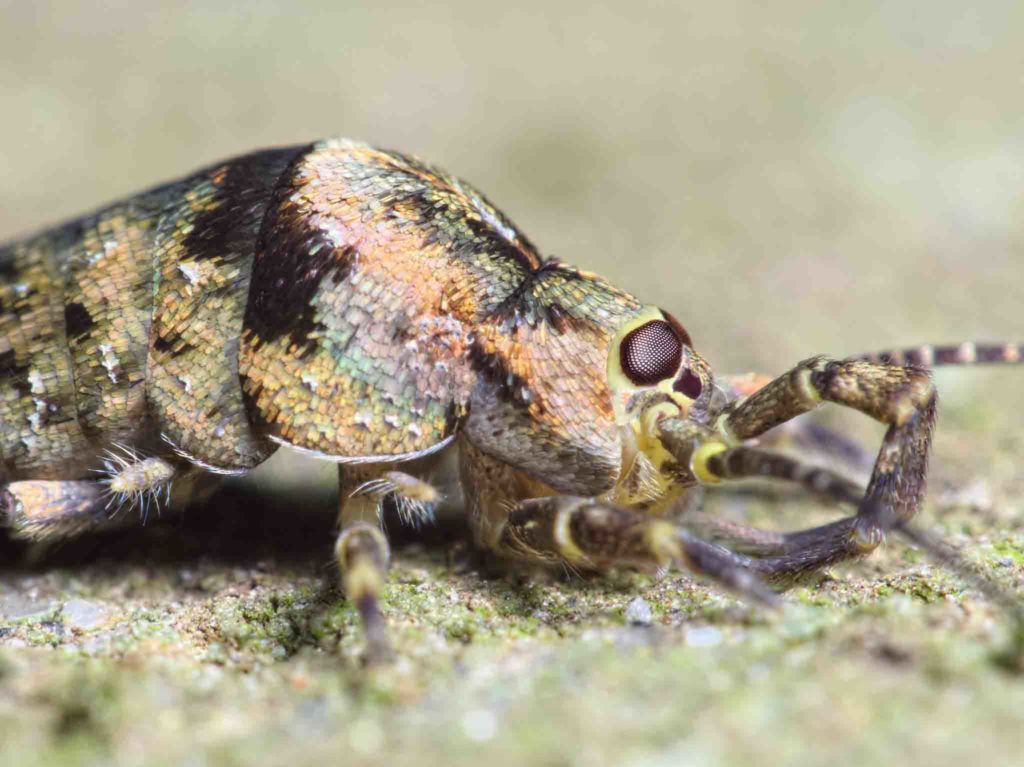They live in your yard. But you may not know of them, so what might be the most important things to tell you about jumping bristletails? Well . . . first of all, they aren’t silverfish! They’re often misidentified as such—was that your first guess when you saw the above photo? They don’t invade homes. And they aren’t pests. Instead, they’re beneficial as recyclers of organic matter. The reason for their name, “jumping” earwig, is obvious when you startle them: they can propel themselves as much as 4 inches (10 cm) forward if a predator is heavy in pursuit. There are about 250 species worldwide, including the Arctic, with 24 of them in North America.
Jumping bristletails are most active at night, but they can be found in the daytime in leaf litter and other decomposing matter, under bark, stone, rocks, and in crevices. Most like moist soil and wooded habitats, but some are found in grassy and rocky environments.
Jumping bristletails were among the very first insects on Earth. Fossil evidence shows they first appeared along with arachnids in the mid-Devonian period, which was 419.2 to 358.9 million years ago. They belong to the order Archaeognatha (are-KAY-ogg-NATHA or r-kee-OGG-nath-uh), a name formed from the Greek words archaeos, meaning ancient, and gnatha, meaning jaw. Their “ancient jaw” is notable because it has only one condyle (a bone that looks like a knuckle) attaching it to the head, whereas other insects have two. Most jumping bristletails are in the family Machilidae.
Physical characteristics
Jumping bristletails have three body sections: head, thorax, and abdomen. Their body, which has a distinctive hump over the thorax, is long and reaches an adult length of about 0.8 inches (20 mm), not counting the “tails.” There are brownish or yellowish, partially reflective scales covering the body. They have six legs but no wings. Three long tails extend from the tip of their abdomen, and that’s the easiest way to identify them quickly. The tails aren’t actually tails—the center one is called the terminal filament (part of the reproductive system), and the outer two are cerci (it isn’t clear, but they may serve as sensory organs or help to propel the body forward, or both).
The head has two large, compound eyes, which sit toward the back and touch each other. Also, there are three simple eyes, called ocelli, each with only a single lens used to detect the intensity of light and dark. The mouthparts are designed for chewing soft, organic matter. The head also has two long antennae that resemble a chain of beads; they’re very flexible and often swept backward.

Jumping bristletail—notice the reflective scales, hump over the thorax, and large eyes. (Pierre Bornand / iNaturalist; CC BY-NC 4.0)
On the underside of the abdomen are many small, moveable appendages that give the appearance of bristles. They’re called style (plural: styli), and scientists speculate that eons ago, they may have been limbs. However, they don’t play a role in the jumping ability of these insects—to jump, they thrust their abdominal muscles rapidly and forcefully against the ground, which gives them lift-off.
Jumping bristletail or silverfish?
At first glance, jumping bristletails look like silverfish. That’s because they’re wingless, scurry around in much the same way, and are fast runners. There are differences, though.
- Jumping bristletails are brownish or yellowish and have mottled or nondescript patterning; most silverfish have a metallic shine to their body.
- Jumping bristletails have a hump above their thorax; silverfish are flat-ish.
- The eyes of jumping bristletails are large and touch in the middle; a silverfish’s eyes are small and don’t touch.
- Jumping bristletails seldom go indoors and don’t reproduce there; silverfish are guilty on both counts.
- Jumping bristletails can launch themselves forward; silverfish run.
Life cycle
Jumping bristletails undergo ametabolous development, meaning they progress through three life stages: from egg to nymph to adult. When they leave their eggs, they look like tiny versions of their parents and gradually grow into full adult size. Unlike other insects, they’ll molt throughout their lives—up to 35 times!
Nymphs don’t reach sexual maturity until they’ve molted at least eight times, which takes about two years. Even then, their sexual activity is strictly solitary. Here’s why: The male spins a thread from his abdomen, attaches it to a surface, and then places packets of his sperm (spermatophores) along its length. It’s left for a female to find. That is a rather haphazard system, so males of some species try to better their odds by luring females through elaborate courtship rituals, but never do they “couple” as, well, a couple! Females will lay about 30 fertilized eggs (in crevices) each time. The eggs may stay dormant for a year before hatching. Females don’t store sperm and acquire a new spermatophore before each egg-laying event.
Food sources
Bristletails eat dead leaves, algae, fungi, lichens, and decaying vegetation.
Predators
It’s thought their main predators are spiders.
In your yard: mayflies
All about termites, surprisingly beneficial
Cockroaches: Only a few give others a bad rap






